Introduction
In the competitive world of plastic machinery manufacturing, one Chinese company has risen to dominate global markets through a combination of strategic innovation and calculated expansion. Haitian International, headquartered in Ningbo, China, now commands over 30% of the worldwide injection molding machine market – a remarkable achievement in an industry long dominated by European and Japanese brands.
This case study examines Haitian’s journey from a domestic manufacturer to global leader, analyzing the key decisions and technologies that propelled its growth while exploring challenges it faces in maintaining industry leadership.
1. Company Background: Foundations of Success
1.1 Humble Beginnings to Market Dominance
- Founded: 1966 as a state-owned enterprise
- Privatized: 1994, beginning aggressive expansion
- Current Status:
- 8 production bases worldwide
- 2023 revenue: $2.1 billion
- 45% of sales from international markets
1.2 Product Portfolio Strategy
Haitian’s three-tier brand approach:
- Haitian Standard: Value-oriented machines (60% of sales)
- Zhafir: Mid-range European-designed systems
- Mars: All-electric premium series
Key Insight: This multi-brand strategy allows coverage of 90% of market segments
2. Core Competitive Advantages
2.1 Unmatched Production Scale
- Ningbo Mega-Factory:
- 1.2 million square feet
- Capacity for 35,000 machines annually
- Vertical integration (75% components made in-house)
Comparative Advantage: 15-20% lower production costs than German competitors
2.2 Strategic Technology Acquisition
- European Partnerships:
- 2007: Technical collaboration with German Demag
- 2016: Acquisition of Zhafir (Germany)
- 2021: Joint venture with Swiss precision component makers
Result: Closed technology gap with Western manufacturers in just 15 years
2.3 Lean Manufacturing Adaptation
- Modified Toyota Production System:
- 58% reduction in assembly time (2015-2023)
- Inventory turnover improved from 3.2 to 5.8 annually
- Defect rate below 0.8% (industry average: 2.5%)
3. Globalization Strategy: Step-by-Step Expansion
3.1 Phase 1: Emerging Market Dominance (2000-2010)
- Target Regions: Southeast Asia, Middle East, Africa
- Tactics:
- Localized service centers
- “Good enough” technology at 40% lower cost
- Turnkey solutions for small manufacturers
Outcome: Became #1 in 15 developing nations by 2012
3.2 Phase 2: Developed Market Penetration (2010-Present)
- European Breakthrough:
- Opened Czech Republic factory (2019)
- Zhafir brand positioned as “European-designed”
- Achieved 12% market share in Germany
- North American Growth:
- Mexican plant serving US market (2022)
- Compliance with UL and OSHA standards
- Now 8% of US mid-range market
Key Stat: International sales grew from $120M (2010) to $945M (2023)
4. Technology and Innovation Roadmap
4.1 Electric Machine Development
- Mars Series Progress:
- 2015: First-gen all-electric (50% imported components)
- 2023: Third-gen (85% localized, 20% more energy efficient)
Market Impact: Now 15% of Haitian’s sales vs. 3% in 2018
4.2 Smart Manufacturing Integration
- Haitian 4.0 Platform:
- Machine connectivity standard since 2020
- Cloud-based monitoring for 60,000+ installed units
- Predictive maintenance reducing downtime by 35%
4.3 Sustainability Initiatives
- Circular Economy Focus:
- Recycled material processing packages
- Energy recovery systems on 90% of new models
- Solar-powered Ningbo facility (30% energy offset)
5. Challenges and Strategic Responses
5.1 Perception Challenges in Premium Markets
- Brand Equity Gap:
- Average selling price still 25% below German competitors
- Solution: Acquired European brands for top-tier positioning
5.2 Geopolitical Factors
- Trade Barriers:
- US tariffs circumvented via Mexican production
- European anti-dumping duties avoided through Czech operations
5.3 Technology Catch-Up Requirements
- Remaining Gaps:
- Ultra-high precision machines (>0.005mm tolerance)
- Micro-molding applications
- Response: $150M annual R&D budget (up from $25M in 2010)
6. Future Growth Strategies
6.1 Next-Generation Factories
- Ningbo Phase IV Expansion:
- Fully automated production lines
- Lights-out manufacturing capability
- Target: 50,000 machines/year capacity
6.2 Service Business Expansion
- From Hardware to Solutions:
- Remote maintenance contracts
- Process optimization services
- Target: 20% revenue from services by 2028
6.3 Emerging Technology Bets
- Strategic Investments:
- Additive manufacturing hybrid systems
- AI-powered quality control
- Hydrogen-powered injection molding trials
7. Lessons for the Industry
7.1 Blueprint for Emerging Market Manufacturers
- Proven Strategies:
- Technology acquisition + local adaptation
- Gradual market upgrading
- Cost leadership without sacrificing quality
7.2 Warning Signs for Incumbents
- Vulnerabilities Exposed:
- Over-reliance on premium branding
- Slow response to electric machine transition
- Underestimation of Chinese engineering capabilities
Conclusion
Haitian International’s rise mirrors China’s manufacturing evolution – from copycat to innovator, from domestic player to global challenger. While European and Japanese manufacturers still hold advantages in ultra-high-end segments, Haitian has demonstrated that disciplined execution of technology development and geographic expansion can reshape entire industries.
The coming decade will test whether Haitian can maintain its momentum while navigating increasing trade tensions and the sustainability transformation. One thing remains certain: the plastic machinery landscape will never be the same.
Discussion Question: Can Haitian’s growth model be replicated in other industrial machinery sectors, or was their success unique to plastic manufacturing conditions?






Add comment